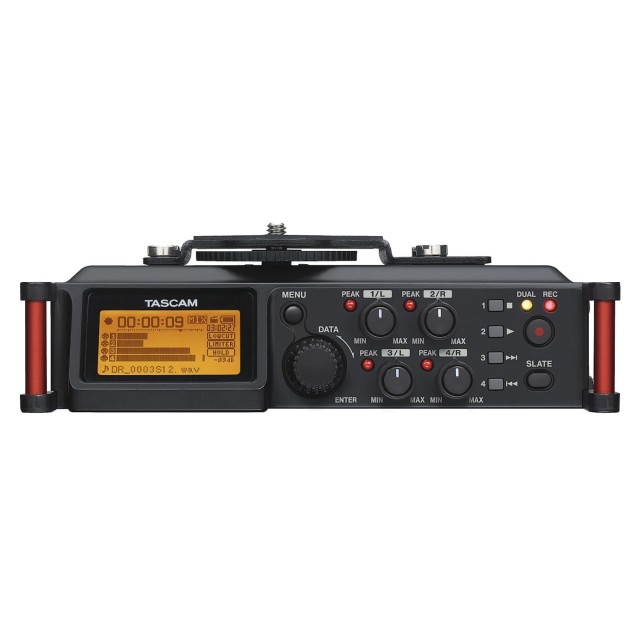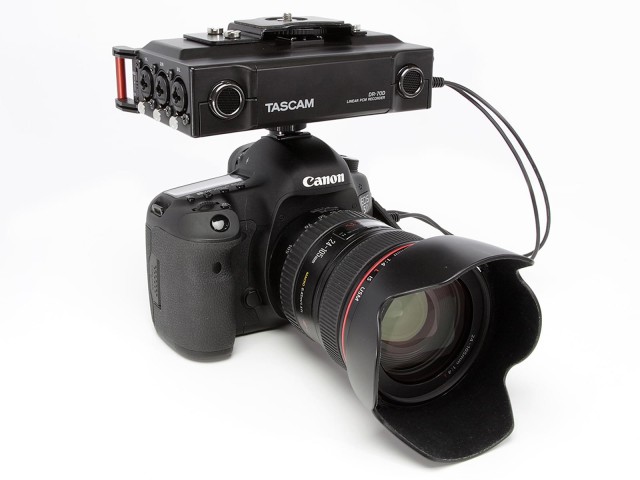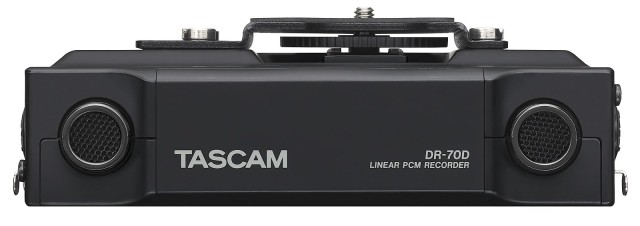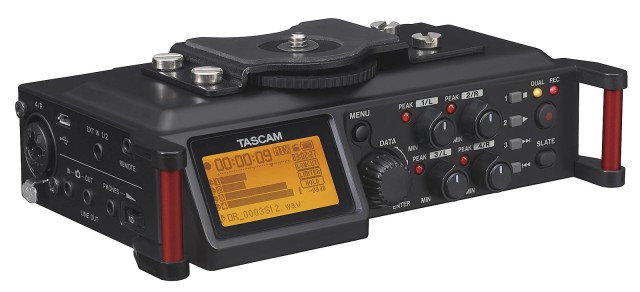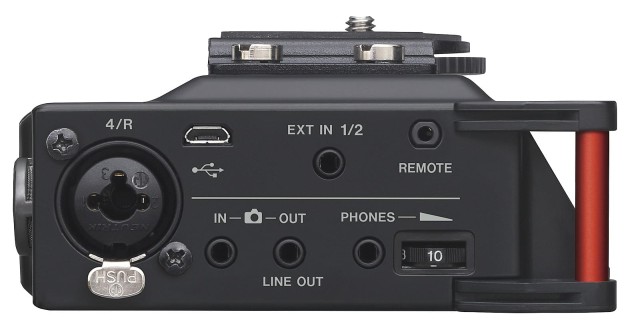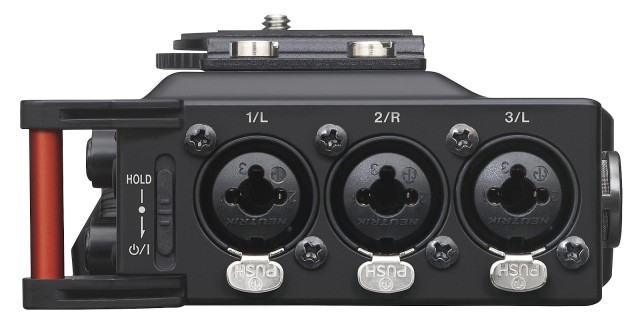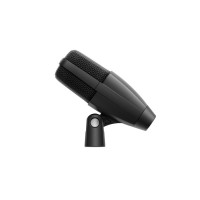
- Search
-
Login
-
0
ComparisonAdd products to compare, then they will appear here and you can compare parameters.
-
0
0 €Nothing in the basket.
Tascam DR-70D 4-channel audio recorder for DSLR cameras
The DR-70D is a compact audio recorder that allows the aspiring DSLR user to create audio recordings in very high quality in parallel to their film or video shots. The recorder can be mounted directly between a tripod and the camera or on top of the camera, resulting in a compact package.
Top accessories for Tascam DR-70D 4-channel audio recorder for DSLR cameras
Product description
The DR-70D is a compact audio recorder that allows the aspiring DSLR user to create audio recordings in very high quality in parallel to their film or video shots. The recorder can be mounted directly between a tripod and the camera or on top of the camera, resulting in a compact package.
With its two built-in microphones, the DR-70D is instantly ready for use in standard situations. In addition, it provides four XLR/TRS combo jacks which can be used to record four channels of audio with excellent sound quality using professional microphones. Thanks to a camera output the recorder’s stereo signal can be recorded also on the camera to ease subsequent editing of the material in combination with the slate tone function of the recorder. On the other hand you can use the camera input to monitor the audio of the camera using the recorder.
Features of the DR-70D include overload-resistant, great-sounding preamps with switchable low-cut filter and limiter, handling of microphone signals in mid/side format, 24- or 48-volts phantom power for condenser mics, as well as many common and not so common functions that facilitate capturing, monitoring and subsequent processing of the audio tracks.
Two built-in microphones
The two omnidirectional microphones allow you to easily record natural stereo sound with just this unit. Used together with small shotgun mics, you can even record audio from people speaking in an interview and the ambient sound at the same time (on different tracks), for example, with a compact set up.
4 XLR/TRS combo jack allows a wide range of setups
The four-channel design enables use of two shotgun mics and the stereo mic to record ambiance and each speaker individually. Since channels 1 and 2 can be set to the stereo input and channels 3 and 4 can be set to the built-in mic, a large variety of microphone setups is possible.
- MONO/DUAL MONO mode: This is best for recording the audio of a single performer.
- STEREO/DUAL STEREO mode: This is best for recording with the built-in microphone or a stereo mic.
- 2MIX/DUAL 2MIX mode: This creates stereo files of the signals of multiple inputs that have been mixed.
Built-in mixer with 4 inputs and 2 outputs
The mixer can take a total of 4 channels from among the four XLR inputs that support phantom power, the stereo mini-jack input and the built-in stereo mic. In addition to adjust pan and input level, this unit also offers a limiter, a five-setting low-cut filter and a delay that can compensate for distances between mics. Moreover, a mid-side decoding function allows the use of two microphones in mid-side configuration.
High audio quality through HDDA micrphone preamps
Mic preamps, which receive and amplify microphone input signals, have a large impact on the quality of the recorded audio material. The DR-70D uses Tascam original HDDA (High Definition Discrete Architecture) microphone preamps that we created through careful selection of parts. For example, we chose the NE5532 for the operational amplifier, which has a strong effect on audio quality. With a mic amp circuit that uses discrete architecture comprised of meticulously-chosen parts, we have achieved an equivalent input noise of −120 dBu.
The A/D converter that converts analogue signals to digital is made by Cirrus Logic and is equivalent to those used in our successful DR series of linear PCM recorders. Recording at resolutions up to 96 kHz/24 bit is supported.
Compact and tough design
The designer of the DR-70D focused on making the unit small so that it does not interfere with camera-work when it is attached to a camera support system or stabilizer. The unit has tripod screw threads on the bottom side and a removable camera attachment screw on its top. A hot shoe mount is also included so you can attach the recorder in the way most convenient for you by placing it between a tripod and the camera or on top of the camera with a hot shoe.
- Stand adapter (¼ inch) on bottom side to attach the unit to a tripod
- DSLR bracket for easy camera attachment and removal
- Hot shoe mount (accessible when not using the DSLR bracket)
- Handles on the front left and right sides protect the screen and can be used to attach a shoulder belt
Camera input and putput
The DR-70D has a camera input jack that can be used to monitor the audio from the DSLR camera. By using this with the DR-70D monitor selection function, you can efficiently monitor the audio from not only the DR-70D but also from the DSLR camera.
The camera output jack is designed to output the mixed audio to the camera so that the same audio can be recorded by the DR-70D and the camera. Since the input level varies by camera maker and there are usually few adjustments related to volume on DSLR cameras, this unit has an output volume dial that can be used to make adjustments.
Slate tone generator for easy alignment with video files
The built-in generator can produce slate tones that can be used as references when aligning audio and video. In addition to being able to produce slate tones when recording starts or when it starts and stops, the SLATE button can be used to add slate tones at any desired point.
- Automatic insertion: Choose from inserting a slate tone at the beginning of recording or at both the beginning and end of recording
- Manual insertion: Press the SLATE button to produce a tone.
SPECIFICATIONS
| General | |
|---|---|
| Recording media | SD cards (64 MB – 2 GB) SDHC cards (4–32 GB) SDXC cards (48–128 GB) |
| Recording/playback formats | WAV: 44.1/48/96kHz, 16/24-bit BWF: 44.1/48/96kHz, 16/24-bit |
| Number of channels | 4 maximum (stereo × 2) |
| Analogue audio inputs and outputs | |
|---|---|
| 1/L, 2/R, 3/L, 4/R | XLR-3-31, 6.3-mm standard TRS jack (can provide phantom power) |
| EXT IN 1/2 | 3.5-mm stereo mini jack (can provide plug-in power) |
| IN | 3.5-mm stereo mini jack |
| PHONES | 3.5-mm stereo mini jack |
| OUT/LINE OUT | 3.5-mm stereo mini jack |
| Other inputs and outputs | |
|---|---|
| USB port | Micro-B connector |
| Format | USB 2.0 HIGH SPEED mass storage class |
| REMOTE input | 2.5-mm TRS jack |
| Audio performance | |
|---|---|
| Frequency response (LINE IN or MIC IN to LINE OUT, JEITA) | 20 Hz – 20 kHz +0.5/−2 dB (Fs 44.1/48 kHz) 20 Hz – 20 kHz +0.5/−3 dB (Fs 96 kHz) |
| Distortion (LINE IN or MIC IN to LINE OUT, JEITA) | 0.02 % or less (Fs 44.1/48/96kHz) |
| S/N ratio (LINE IN or MIC IN to LINE OUT, JEITA) | 92 dB or more (Fs 44.1/48/96kHz) |
| Equivalent input noise (EIN) | −120 dBu or less |
| Figures are based on JEITA CP-2150 |
| Recording times (4-GB SDHC card, hours: minutes) | |
|---|---|
| WAV/BWF 16 bit/44.1 kHz (stereo) | 6:44 |
| WAV/BWF 24 bit/96 kHz (stereo) | 2:04 |
| The recording times shown above are estimates. They might differ depending on the SD/SDHC/SDXC card in use. The figures reflect the total possible recording time for the specified card. If recorded in mono WAV format, the maximum recording time will be double the figures above. When using dual/4-channel recording in WAV/BWF format, the maximum recording time will be about half the figures above. |
| Power supply and other specifications | |
|---|---|
| Power | 4 AA batteries (alkaline or NiMH) USB bus power from a computer AC adapter (TASCAM PS-P520U, sold separately) External battery pack (TASCAM BP-6AA, sold separately) |
| Power consumption | 5 W (maximum) |
| Dimensions (W × H × D) | 169 mm × 55 mm × 107 mm (with top adapter attached) |
| Weight | 625 g (including batteries) 530 g (excluding batteries) |
| Operating temperature range | 0–40 °C |
| Approximate battery operation time (continuous operation, hours:minutes) | |
|---|---|
| Alkaline batteries (EVOLTA) | |
| 2-ch recording, WAV format, 44.1kHz/16-bit | 6:00 (XLR/TRS input selected, phantom power not used) 11:00 (MIC input 3/4 selected) |
| NiMH rechargeables (eneloop) | |
| 2-ch recording, WAV format, 44.1kHz/16-bit | 6:15 (XLR/TRS input selected, phantom power not used) 10:30 (MIC input 3/4 selected) |
| NOTE: When using phantom power, the operation time might be reduced depending on the mic being used. |
ACCESSORIES (11)
RODE VideoMic NTG
Canare L-2T2S microphone cable 6,0mm, XLR (M) / XLR (F) 1m, BLK
Sennheiser MKE 200 Directional Camera Microphone
RODE HJA-4 -3.5mm to ¼-inch Headphone Adaptors
CANARE L-2E5 microphone cable 4,6mm, XLR(M) / JACK 3,5mm TRS (M) 0,5 m, BLK
RODE VideoMic Pro+
Sennheiser MD 421 KOMPAKT
Rode NTH-100 Professional Over-Ear Headphones
Canare L-2T2S microphone cable 6,0mm, XLR (M) / JACK TRS 6,3mm 2m, BLK
Sony ECM-678
Yamaha HPH-MT7W
Alternative (2)
- Show all

Tascam DR-70D 4-channel audio recorder for DSLR cameras
The DR-70D is a compact audio recorder that allows the aspiring DSLR user to create396 €on request
Sony SAD-V77B (10pack)
The Sony Vertical Clip for ECM-77 Microphone SAD-V77B (10 Pack) is a clip designed317 €on request
CONST LB-190V V-mount 190Wh Li-ion battery
CONST LB-190V V-mount Li-ion battery (12.8Ah, 190Wh, 14.8V)299 €on request
Canare BCJ-JR Panel mount connector
Canare BCJ-JR is a 75 ohm BNC(F) / BNC(F) double-sided Panel mount connector2.3 €In stock 2 pcs
Neutrik NTP3RC
Neutrik NTP3RC - 3 pole 3.5 mm audio plug, solder termination, chuck type strain5 €To be sent > 5 pcs
Lilliput HT5S
HT5S 5.5" Ultra High 2000 Nits Brightness Touch On-Camera Control Monitor338 €In stock > 5 pcs
Presonus Atom
Capture the beat whenever and wherever creativity strikes with PreSonus®’ ATOM. An127 €To be sent 1 pcs
Rean NYS231LBG
Rean NYS231LBG - 3 pole 3.5 mm plug, black metal handle, gold plated contacts2.6 €In stock 2 pcs


